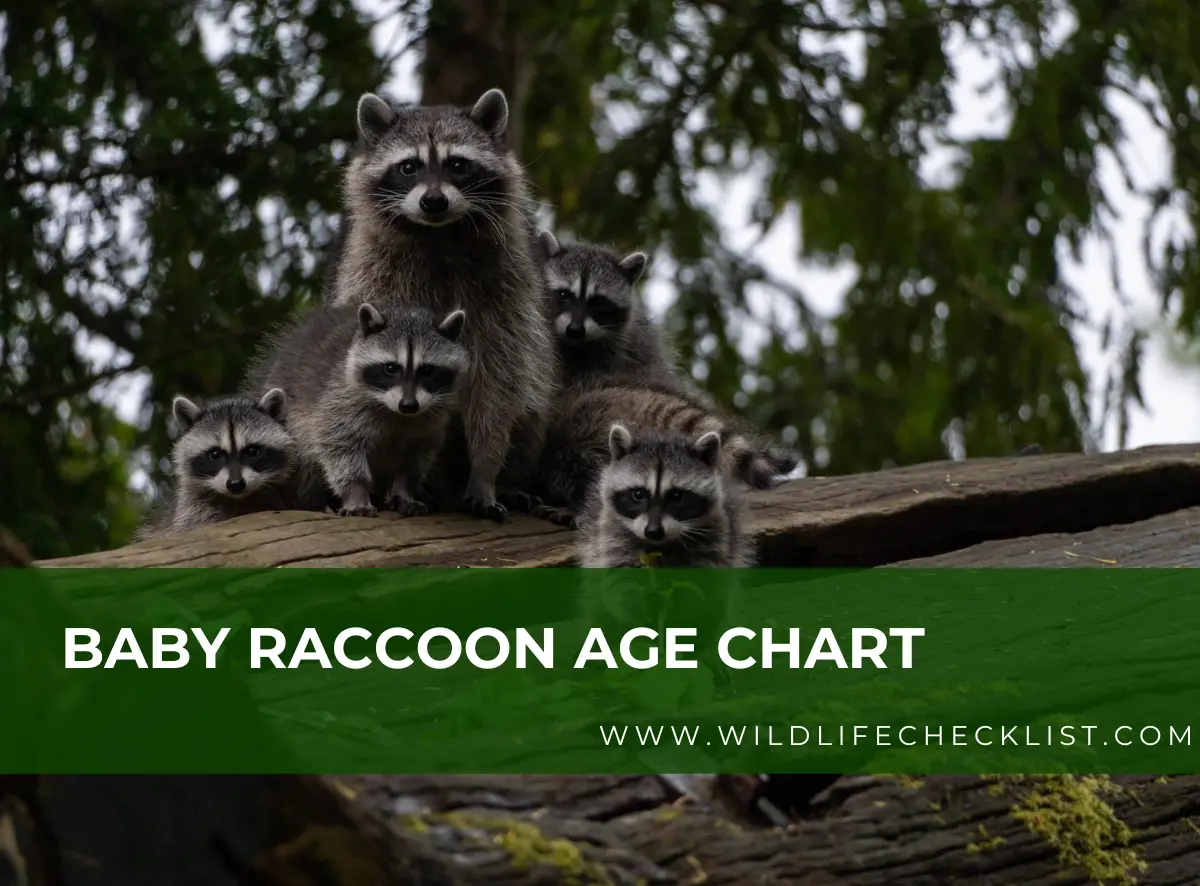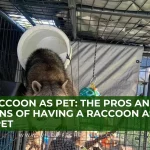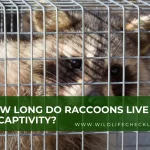Baby Raccoon Age Chart: Everything You Need to Know

Are you fascinated about knowing how to take care of a baby raccoon? Or maybe you found an orphaned baby raccoon and wonder how old it is? Knowing a baby raccoon’s age is important because it determines how much and how often to feed them. A baby raccoon age chart will help you determine how old that cute raccoon is.
Below is a baby raccoon age stages chart to help you determine how old your little raccoon is.
| AGE | DESCRIPTION |
|---|---|
| Newborn (1 or 2 days old) | At this age, baby raccoons are tiny with giant mouths, and their eyes and ears are closed. All they do at this age is to eat and sleep, although they react to touch or temperature changes. For the first week to so, they eat six times a day, every four hours around the clock. |
| 1-2 weeks old | At this age, baby raccoons are tiny, and their eyes and ears are still closed. They still eat six times daily, but the frequency can be reduced to every five hours. |
| 3-4 weeks old | At this age, baby raccoons’ eyes and ears are open, and they are starting to explore their surroundings. They are still nursing but can be introduced to solid food. |
| 5-6 weeks old | At this age, baby raccoons are becoming more active and playful. They are eating solid food and nursing less frequently. |
| 7-8 weeks old | At this age, baby raccoons are fully weaned and eating solid food exclusively. The raccoons start becoming more independent and also explore their surroundings. |
| 9-10 weeks old | At this age, baby raccoons are almost ready to be released into the wild. The raccoons started becoming more skilled at climbing and foraging for food. |
Contents
How to Tell the Age of a Baby Raccoon
Knowing the age of a baby raccoon involves observing various physical characteristics and developmental stages. Newborn raccoons are typically born in litters of two to five. As raccoons age, their fur changes from black to gray. You can examine their wrinkles around the eyes and mouth; older raccoons tend to have more wrinkles due to skin losing elasticity.
- Size: Young raccoons are smaller than adults. Compare the size of the baby raccoon to that of a full-grown adult raccoon to estimate its age.
- Fur: Baby raccoons are born with a light covering of fur. As they grow, they have their furs more denser and more developed. The quality of fur can give you an idea of their age.
- Eyes: Newborn raccoons have closed eyes, typically open at around three weeks. The appearance and clarity of their eyes can help you know their age.
- Teeth: Baby raccoons’ teeth start coming in at about 2-3 weeks old. Having teeth and their development can give you clues to their age.
- Behavior: Younger raccoons might have more uncoordinated movements and less agility than older ones.
- Wrinkles: As raccoons age, wrinkles can develop around their eyes and mouth. Older raccoons tend to have more pronounced wrinkles due to the loss of skin elasticity.
- Activity: Older raccoons become more active and independent as they grow. Younger ones might still be closely attached to their mother.
- Socialization: Baby raccoons become more social as they mature. If you notice a raccoon interacting with others of similar size, it might be around the same age.
It is vital to note that these are general guidelines, and variations can occur. Contact wildlife experts or rehabilitators experienced in handling raccoons if you need more information.
At What Age do Baby Raccoon Open Their Eyes?
Baby raccoons, also known as kits, are born with closed eyes and ears. This means that they are born deaf and blind. Their eyes typically open at around three to four weeks of age.
During the first two weeks, baby raccoons are tiny; all they do is eat and sleep. Baby raccoons’ eyes and ears are closed and don’t move around much. After the second week, their eyes start to open and become more active, though their eyesight and hearing are not fully developed until the three to four-week mark.
The gradual process of eye-opening and sensory development is something they need to survive. This is because they transition from total dependence on their mother to a more independent stage of their life.
How Long Can a Baby Raccoon Survive Without Its Mother?
Baby raccoons are born blind and deaf, which makes them 100% dependent on their mother’s care. As baby raccoons, these do last around 2-3 weeks. After this stage, the mother nurses the baby raccoon for about three months, but it may still need help finding food and shelter even after it has been weaned. Up to nine months after birth, the baby raccoon remains heavily dependent on its mother and cannot survive without her.
However, raccoon families have been found to stay together for up to a year before the babies move on and separate from their litter. An answer to the question “How long can baby raccoons live without their mother?” is determined by factors such as the raccoon’s age, health, and the season.
A one-year-old raccoon in good health stands a good chance of making it in the wild, but a newborn is unlikely to survive without help. Baby raccoons stand a better chance of surviving for a few weeks without their mother if they have been weaned, the weather is warm, and they are in good health. They may only survive for a few days if separated from their mother, or they are orphans.
It is important not to trap and relocate adult raccoons as this could inadvertently cause a litter of babies to be orphaned. If a newborn raccoon is found in the wild, it’s best to stay away from it and watch it because the mother may be nearby and will come for it if it seems healthy and doesn’t show any obvious indications of injury.
The best action is to contact a wildlife rescuer if the mother doesn’t show up to collect the offspring within a day, as it’s typically reasonable to presume she won’t be arriving at all.
At What Age do Baby Raccoons Leave Their Mother?
Baby raccoons leave their mother at around 10-12 weeks, although some may stay in the nest for up to 16 weeks. During this time, the mother raccoon is incredibly protective of her young and will attack anything close to their family.
The kits must learn survival skills and gain independence before venturing out independently. The process of baby raccoons leaving their mother is gradual. Raccoons mature into more curious and daring creatures who explore their surroundings while their mother watches them.
They venture further away from the nest, gradually increasing their independence. Male raccoons tend to be more independent and stray further from the nest, while females often stay closer to their mothers. This behavior from raccoons is said to be connected to raccoons’ mating behaviors.
Male raccoons must establish their territories and find mates, while females may stay near their mother’s territory. It is worth noting that some raccoons may stay near the nest for up to one year before moving on and separating from their litter.
Raccoons get the chance to learn different survival methods from their mother and siblings throughout this prolonged period. Once they feel confident and capable, they eventually leave to establish their territories and start their own families.
Baby raccoons can leave their mothers any age, but it usually happens between 10 and 12 weeks. The kits progressively gain independence and begin to explore their surroundings with the assistance of their mother. Male raccoons tend to be more independent, while females often stay closer to their mothers. Before moving out on their own, the kits can acquire vital survival skills by spending prolonged time close to the nest.
How do the Vocalizations of Baby Raccoons Change as They Age
Raccoon babies are particularly loud mammals, and they interact with each other by making a range of noises. Their vocalizations alter as they age to reflect their shifting demands and situations. The vocalizations of young raccoons alter in the following ways as they get older:
It is important to note that the sounds of baby raccoons can depend on their age, circumstances, and environment.
What Age is a Baby Raccoon Weaned?
Raccoon babies are normally weaned between 10 and 12 weeks old. The raccoons can survive on their own at this age without getting any assistance from the mother raccoon. On the other hand, Raccoon families have been observed to remain together for up to a year until the young depart and split from their litter.
Baby raccoons gradually switch from their mother’s milk to solid meals throughout the weaning phase. Raccoons start eating “grown-up” food, such as mice, chicks, and smelt, when they are about 8 to 10 weeks old. They become independent and active individuals who climb and explore their surroundings.




